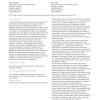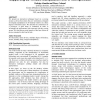NORDICHI
2006
ACM
14 years 6 months ago
2006
ACM
Experience Design is an emergent field of study, and various approaches to the field abound. In this paper, we take a pragmatic approach to identifying key aspects of an experienc...
NORDICHI
2006
ACM
14 years 6 months ago
2006
ACM
While various models of undo have been proposed over the years, no empirical study has yet been done to discover which model of undo most closely aligns with what users expect an ...
NORDICHI
2006
ACM
14 years 6 months ago
2006
ACM
We present an interaction technique based on a yawing mouse (a device that senses the yaw orientation), designed for integral manipulation of 3D desktop windows in a three degrees...
NORDICHI
2006
ACM
14 years 6 months ago
2006
ACM
Recently, more and more attention has been paid to emotions in the domain of Human-Computer Interaction. When evaluating a product, one can no longer ignore the emotions a product...
NORDICHI
2006
ACM
14 years 6 months ago
2006
ACM
Users should be involved in the development of information technology (IT) artifacts. However, this is challenging, especially in product development context, in which Human Compu...
NORDICHI
2006
ACM
14 years 6 months ago
2006
ACM
In this paper we discuss why access to mathematical graphs is problematic for visually impaired people. By a review of graph understanding theory and interviews with visually impa...
NORDICHI
2006
ACM
14 years 6 months ago
2006
ACM
This paper describes a series of user-centred design sessions conducted with children of varying ages to explore near-future applications of sensor-based technologies. We explain ...
NORDICHI
2006
ACM
14 years 6 months ago
2006
ACM
NORDICHI
2006
ACM
14 years 6 months ago
2006
ACM
Downstream utility is a critical success factor for usability evaluation methods, in terms of the extent to which they can deliver value. In this paper we argue that field methods...
NORDICHI
2006
ACM
14 years 6 months ago
2006
ACM
How do individual HCI-practitioners evaluate their own work practice? And how would they like to evaluate it? Answers to these questions will give new knowledge on the state-of-th...



